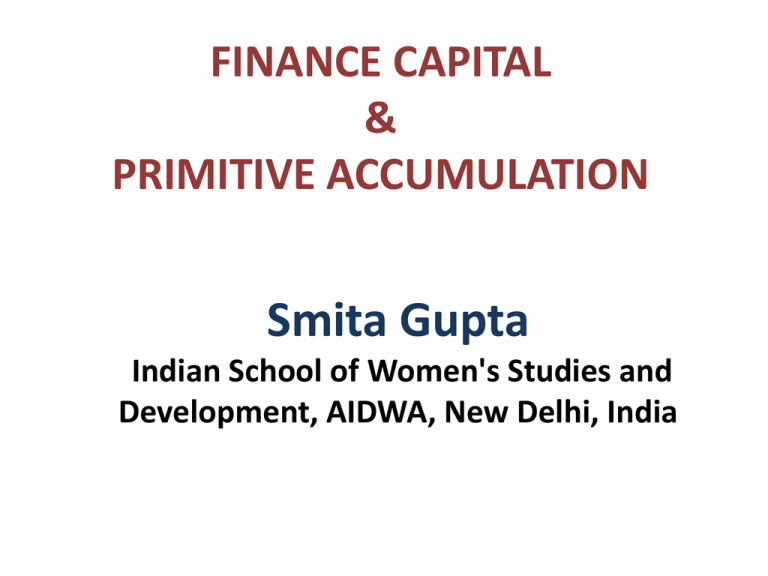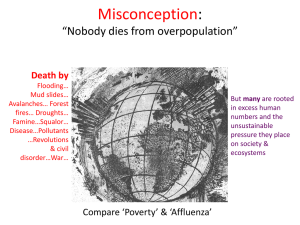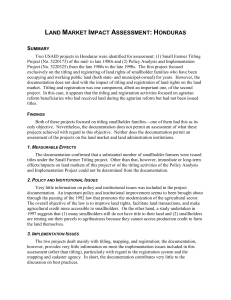The neo-liberal Act
advertisement

FINANCE CAPITAL & PRIMITIVE ACCUMULATION Smita Gupta Indian School of Women's Studies and Development, AIDWA, New Delhi, India PRIMITIVE ACCUMULATION Primitive accumulation best explains surge in dispossession after advent of finance capital driven neo-liberal policies in India. PA has to be clearly understood as the separation between resources and petty producers, as inherent to and even ‘constitutive’ of capitalism, and not necessarily as a transition between modes of production, limited to capitalism’s pre-history. Nor is PA a transient ‘fix’ to crisis or an aberration ( as Harvey suggests), not part of the pure “logic of capital”. PA and capitalist accumulation differ in terms of how the separation between producers and resources occurs: through extra economic coercion or through “the silent compulsion of the market” (which Harvey wrongly elevates to the pure “logic of capital”). Through the submission of ‘living labour’ to the reign of capital and separation of direct producers from their means of production and subsistence, PA both facilitates and is an outcome of the internationalization of the ‘circuit of capital’ under neoliberal policies. The wider appeal of Harvey’s neo-Smithian formulation of PA which tends to sanitize capitalism of its repugnant bloody and brutal aspects lies in its view of present day imperialism (“new deal” in Harvey’s formulation) as benign and acceptable. Neo-liberal Reforms in India • Replaced post-independence regulatory and protectionist framework – disparagingly called ‘license permit raj’ –with fiscal conservatism, deregulation, trade liberalization, financial sector reforms and privatization. • Abandoned developmental, welfarist and protective role of State. This happened through three mutually reinforcing processes, (a) A sharp decline in state expenditure on policies for socio-economic development and welfare to retain the “confidence of investors”. (b)Devastation of national production activities due to competitive cheap imports due to trade liberalization (c) incentivizing private investment in infrastructure, urbanization and industries through tax and price concessions and handover of natural resources to unleash “animal spirits” • Priority given to attracting foreign investment and the lifting of restrictions on private corporate investment generated an extraordinary ‘race to the bottom’ among the state governments, competing to offer more and more attractive concessions to woo private capital. • • • • • • POLICIES PROMOTING SPECULATIVE SQUATTERS AND PLUNDER The growth model requires the state to unleash ‘animal spirits’ for an ‘investor friendly environment’, like Bentham’s ‘laissez-faire authoritarianism’, ‘liberty’ of capital depends on subordination of labour and resources to capital’s will. The global circuit of capital in its financialized phase and the thrust for free trade and attack on agriculture has as its primary aim the re-opening of the lands of the global South to possess and annex tropical biodiversity This results in environmentally unsustainable and socially inequitable plunder of natural resources, and the subjugation and disciplining of labour through deregulation and growing labour reserves. Public policy either privatizes or statizes land. As the neoliberal state abandons the dirigisme’s conception of holding natural resources in public trust statization and privatization have the same outcome – dispossession of direct producers and hoarding by big private players. The pressure from World Bank etc. to end community land systems, a key “impediment” to the penetration of global capital esp in mining and infrastructure. All open CPRs must be enclosed, and traditional rights restricted, otherwise investors will have to negotiate with individual communities for their resources. The private players increasingly are speculative squatters, rarely using the annexed resources “productively”. Even after receiving all the “incentives” from the state, the land resources are financialized often using shell companies • In the last quarter Century, India experienced renewed plunder and loot of land and land-based natural resources on a hitherto unprecedented scale, as the means to boost capitalist super-profits. • It also witnessed agricultural distress because of the agrarian crisis brought on by rising costs, falling prices and trade liberalization resulting in low growth, falling profitability, growing landlessness, casualisation of labour, increase in small and marginal holdings and fragmentation, and widening rural-urban gap • The fragility of rural livelihoods due to falling viability of cultivation and squeeze on off-farm employment, has rendered rural workers extremely vulnerable to even the smallest of shocks resulting in distress out-migration. • Environmentally unsustainable land use and technologies as well as inadequate investment on small-scale eco-regenerative labour-intensive land and water conservation have caused huge ecological degradation, destroying the quality and productivity of land resources in agriculture, forestry and allied activities. These three factors, namely, the plunder of land and land-based resources; agrarian distress and environmental degradation have together resulted in dispossession and displacement of large populations • Thus, the current growth model is itself predicated upon state-sponsored encroachment through extra-economic coercion ostensibly for industrialization, urbanization and infrastructure. This has resulting in massive dispossession and displacement of petty producers. Dispossession includes all forms of loss of access to and ownership of these resources – be it private, community or public rights. The notion of dispossession includes: (i) exclusion and loss of access; (ii) outright evictions and loss of ownership, occupation or tenure; and (iii) ecological degradation and loss of soil fertility and bio-mass. • Land resources include forests, minerals, soil, biomass and vegetative cover, water, etc. These exist broadly in three types of property relations: (a) As ‘common property resources’ (b) As ‘state owned resources’ purportedly held in public trust (c) as private property. I use the term land to include all these resources and property relations. • The crucial policy and legislative changes that have led to dispossession include the agrarian crisis and distress; forest laws, fencing and evictions; land alienation; forcible land acquisition; reverse land reforms; enclosures through titling; eco-degradation; changing land use policies and evictions in cities; policies of infrastructure, industrialization and urbanization, etc. SEVEN EXAMPLES OF BLOODY LEGISLATIONS AND POLICIES • FOREST POLICY, EVICTIONS AND DEVERSION • LAND ALIENATION AND INDEGENOUS POPULATIONS • FORCIBLE LAND ACQUISITION • REVERSE LAND REFORMS • ECO-DEGRADATION • ZONING, EVICTION AND SLUM CLEARANCES IN URBAN AREAS • ENCLOSURES THROUGH LAND TITLING • • • • Forests, Diversion and Evictions The State fenced forest land (23% of total area) using the forest conservation act (1980) and the wildlife protection act (1972) to establish pristine inviolate areas free from human activity. These were essentially ‘bloody legislation’ to separate forest dependent communities from the forests and even as they overnight became “encroachers” and were evicted from their own land, the forest land was diverted to mega “development” projects - since 1980 to 2000, an average of about 40,000 hectares was diverted annually, rising to a lakh hectares a year between 2001 and 2006, and currently it is 90,000 hectares. The total land diverted since 1980 is about 14 lakh hectares till March 2014. UPA constituted a Project Monitoring Group in June 2013 and cleared 152 of the 437 projects (each worth >Rs 1,000 crores) totaling about Rs 5.3 lakh crores of a total pendency of Rs 15 lakh crores. NDA reduced the bar on projects to Rs 500 crore. It has also introduced deemed clearances, and a Project would be considered approved if no objections are raised within a specified time period (6 weeks in some cases). For “security” and fighting “Maoism”, they are considered approved on application. DEFINITION OF FORESTS – COVER OR JURISDICTION DEFINITION OF BAMBOO – GRASS OR TREE Adivasi land alienation • Land alienation, a euphemism for land grab of adivasis land by nonadivasis, is widely prevalent despite several policies and laws in place for restoration of lands to adivasis. • The Panchayats (Extension to the Scheduled Areas) Act, 1996 or PESAA has specific provisions dealing with the protection of resource rights of adivasis. This Act has been completely subverted by the state and corporate sector. • The Rules to implement the Act have never been issued by the central government leaving it to the 8 sub national governments. • Not even one out of the 29,596 cases of alienation and restoration were ruled in favour of the adivasis in Madhya Pradesh while in Orissa 43,213 out of 104,644 cases were decided against adivasis. Even Left ruled Tripura rejected 20,043 cases out of the 29,112 cases. • Fifth Schedule States have found a novel way of undermining adivasi land protection: by converting rural areas into urban ones! Since the protection is not extended to urban areas within the Fifth Schedule, the criteria for notifying areas as urban and rural are manipulated and the stringent provisions of PESAA are bypassed by merely re-classifying them as urban so that land can be easily taken over Forcible land acquisition The colonial Act • Till 2013, for over six decades after Independence, the legal framework for land acquisition was provided by the archaic colonial Land Acquisition Act, 1894 (LAA). The main purpose of the LAA was to acquire land in a quick, cheap and easy manner with little concern for livelihoods and rehabilitation of landowners. • One of the biggest weaknesses of the 1894 Act was that “public purpose” is the sole and absolute prerogative of the executive, through opaque and authoritarian procedures not subject to democratic and judicial scrutiny. Land was often acquired in the guise of a more plausible purpose and then transferred to some other use. • The LAA kept acquisition costs low by an unfair and arbitrary method of evaluating the price of land and restrictive coverage of persons and assets resulting in very low compensation. The procurer (the Government) decided the price, and refused to transfer any part of the gains of the higher values accruing from the proposed change in land use to the affected persons, and the payment of depreciated value for assets made it impossible to replace them. The neo-liberal Act • The Right to Fair Compensation and Transparency in Land Acquisition, Rehabilitation and Resettlement Act, 2013, title notwithstanding, replaces a colonial Act with a neo-liberal one. The price for compensation is now linked to the stamp duty and circle rates rather than the highest actual market price as ordered by the Supreme Court, which are notoriously under-reported. The acquirer namely the state continues to determine compensation, which is a conflict of interest. However, the most important departure is the use of the state’s eminent domain and expropriatory powers for private companies by bringing private companies into the very definition of public purpose and effectively abandoning the distinction between acquisition for private companies and acquisition for the state (and state owned companies). • Even though the 1894 Act allows the use of the state’s eminent domain to forcibly acquire land for public purpose acquisition could not be done for “private purposes” of a company simpliciter, and had to be made in the “larger public interest”. This notwithstanding, the courts and the executive had colluded to use the “mischief, defect and the lacuna” in the statute. Parliament has now removed the distinction between acquisition for companies simpliciter and acquisition for public purpose for the state and its “instrumentalities/agencies”, putting it on the same footing. • However, the UPA government was forced to put in very weak and contested but provisions nonetheless for Social Impact Assessment, prior informed consent, higher compensation and greater accountability of government functionaries. • The NDA government has now brought in an ordinance to remove or dilute each and every progressive aspect of the UPA 2013 Act to make it industry friendly. In doing this, the present Government finally becomes what even the Colonial British rulers balked at: real estate agents for private companies. • Public purpose is the sole justification for the expropriation of private land or diversion of common property resources, and legitimizes the use of eminent domain of the state for expropriation. And yet, shockingly, the Ordinance dilutes it even further and removes the only mechanism and procedure for its determination; and removes all limitations and restrictions on the misuse of the powers of eminent domain. • Prior informed consent from the land loosers is another essential part of democratization – this has been rendered ineffective. • In India, there are no systematic official records of the total extent of land acquisition or displacement. Non-official studies quoted by the now wound up Planning Commission suggest that the total number of persons displaced / affected by projects for the period 1947 to 2004 is around 60 million, involving 25 million ha. of land, including 7 million ha. of forest and 6 million ha. other common property. The adivasis constitute 40% of the total displaced/affected persons by projects, while Dalits are 20%. • According to a rare and painstaking study of a single state, Gujarat, based on the perusal of Gazette notifications over 57 years, the State has acquired roughly 3.2 millions hectares of land for development projects and displaced around 25 lakh people, between 1947-2004. Thus around 5% of the state’s total population has been displaced and 16% of its geographical area acquired. Reverse land reforms: • Land reforms were to remove barriers to agricultural investment and remove exploitation in the agrarian structure due to inequality in land distribution and tenurial systems. Abolishing intermediaries, transfer of land to recorded tenants and redistribution of ceiling surplus land were the three pillars. But there was a large gap between law and its implementation. • Of late, policy analysts have suggested rolling back land ceiling laws as they hinder investment and adoption of economies of scale. The fragmentation of landholdings and the dominance of small-holding agriculture are cited as a cause for concern, with some arguing for a bottom ceiling on the smallest size. A corollary to this is the liberalizing of the existing restrictions on agricultural tenancy. • The National Agricultural Policy wants to incentivize reverse tenancy (small lessorlarge lessee) and develop lease market for increasing the size of the holdings by giving private lands on lease for cultivation and agri-business. Further, ‘private sector participation” through contract farming and land leasing arrangements was recommended. • States have moved or proposed amendments for three types of changes : (1) raising land ceiling (2) redefining farming activities to include agro-based industry, farm research, post-harvest agriculture-based companies and infrastructure for farming (3) permitting tenancy (even reverse tenancy) and agriculture-based companies to take land on lease. • Punjab and Haryana have done away with the land ceiling for nonagricultural use, with retrospective effect. In a single stroke, the "grave violations" of land ceiling laws by real estate companies, stocking thousands of acres of land in false names or floating multiple firms to acquire adjacent stretches have got legal sanction. • The ongoing clamour for re-classification of Mangar sacred groves in the NCR by realtors from uncultivable hills to agricultural land has to be seen in light of these amendments. • The Planning Commission set the repeal of the Urban Land (Ceiling & Regulation Act), 1976, within a committed time frame as a precondition for states to access funds under the Jawaharlal Nehru National Urban Renewal Mission (JNNURM). They are then required to constitute ‘Screening Committees’ to decide on the use of land under their possession to be sold for the real estate sector through tender–cumauction. Except for Assam, Bihar and West Bengal, all the others have fallen in line to access funds and free the highly valued urban land for private real estate developers. • • • • Ecodegradation According to the Indian Space Research Organization’s (ISRO), roughly 69 per cent or 228 million hectares of India’s lands are dry, and extremely vulnerable. Desertification threatens one-fourth of India’s geographical area, or 81 million hectares. Satellite imagery from Resourcesat also shows that land degradation has already affected a third of the country’s area at 105.48 million hectares. Environmental degradation have an adverse impact on the access to land and landbased resources, both in terms of quantity and quality. The destruction of the inherent productivity of land –private and common - compels owners to abandon cultivation and collection and be forced to migrate out in search of work. In the arid and semi-arid region of central and western India, distress out-migration from the region is largely because of environmental degradation processes and shrinkages of common property resources. Restricted access and availability of common property would only exacerbate ‘degradation-pushed distress migration’. The combination of three processes – reduction in public investment in employment intensive environmental regeneration; the shrinking of the commons through large infrastructure, urbanization and industrial projects and more draconian property regimes due to enclosing and fencing – increases ‘degradationpushed distress migration’ from private and common lands. Evictions in urban areas • A whole host of reasons, like large infrastructure and development projects; urban renewal and new urbanization; city beautification; safety and security concerns; sports extravaganzas; industry, industrial corridors and Special Economic Zones (SEZs) are uprooting individuals and communities from their homes in cities. • With growing demands on land in urban areas, local authorities are more and more shifting unauthorized settlements and slums of the poor from within the city to its periphery. Furthermore, large sections of the urban poor and working class live as “encroachers” in slums, tenements, pavements, and the like and their occupational rights as squatters are always under threat from imminent eviction. The majority of urban residents in India today exist in various states of illegality. • To make matters worse, their workplaces are increasingly under threat as urban planning and zoning cities has meant relocation of employment-intensive industries outside city limits, for example the relocation in Delhi under Court diktat on account of “pollution”. • With the informal economy emerging as the residual sector engulfing a whole range of street based distress self employment, the attack on street vendors and hoarders with restrictions and regular police and municipal action against them, the urban poor loose out their workplaces too, facing violence, extortion and eviction on a day to day basis. • The two worlds split more and more – the elite into its gated and exclusive townships with private security, ‘world class’ infrastructure and facilities, and the working poor in more and more distant ‘nowhere lands’, falling off the city map. Slum clearance is nothing but an attempt to take over the settlement and habitation of the working poor and Delhi alone plans "voluntary relocation" of another half a million people. The judiciary entered the arena of urban planning in a most draconian and anti-poor form “The Indian capital offers brutal confirmation of Jeremy Seabrook's contention that ‘the word 'infrastructure' is the new code word for the unceremonious clearance of the fragile shelters of the poor.’” The land freed through slum clearances is then used for high value commercial enterprises like malls, complexes, office buildings or luxury housing colonies. • • • • Enclosing through titling: The government wants to confer conclusive ownership titles to landholders through a Land Titling Bill. It is an exercise to “prepare a record of all immovable properties”. It squarely places the onus on the individual through “compulsory intimations to land titling authority” to keep the records updated under threat of punishment, even loss of title to the land or interest in the land, and warns: “All persons are deemed to have notice of every entry in the Register of Titles”. This kind of consolidation and centralization of land records is likely to facilitate even greater dispossession and land grab by becoming a large land bank. It recognizes only two categories of land, private and government, with the latter being a residual category. Community resource rights and common property is not recognized and will be recorded as ‘government land’, thus enclosing commons. It is ambiguous regarded the manner in which tenancy will be recorded, and is likely to result in becoming yet another reason for the concealment of unrecorded tenancy and eviction of poor tenants. The fact that this is to ease market transactions in land becomes clear given the introduction of an “indemnification” clause, in which the government indemnifies any person or entity who acts on the basis of the title in the centralised records and would bear the cost of litigation and ancillary matters if they were to arise. It is not about updating land records. It is not about the accuracy of land records, but about its finality for purposes of determining encumbrances and saleability. It is about deciding on a means by which land may be easily dealt with in the market.









